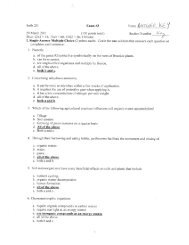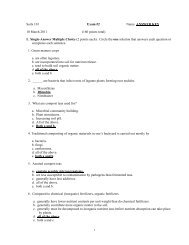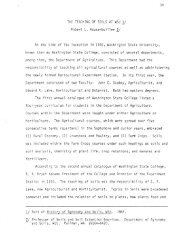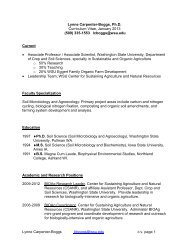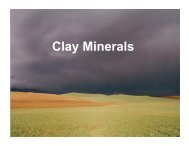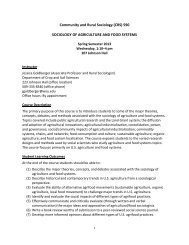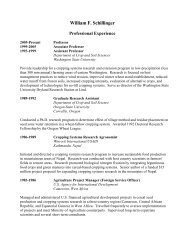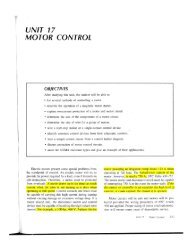2012 Dryland Field Day Abstracts - Dept. of Crop and Soil Sciences ...
2012 Dryland Field Day Abstracts - Dept. of Crop and Soil Sciences ...
2012 Dryland Field Day Abstracts - Dept. of Crop and Soil Sciences ...
Create successful ePaper yourself
Turn your PDF publications into a flip-book with our unique Google optimized e-Paper software.
Page 56<br />
<strong>2012</strong> <strong>Field</strong> <strong>Day</strong> <strong>Abstracts</strong>: Highlights <strong>of</strong> Research Progress<br />
100 lbs/acre in 2008 under extreme drought to 690 lbs/acre in 2011. Winter wheat grain yield in the WW-SF rotation has, to date,<br />
been generally slightly (but not significantly) higher than in the WW-C-SF rotation (Fig. 1). We believe the reason for this is<br />
because soil water in the 6-ft pr<strong>of</strong>ile has been depleted more after camelina than after WW (data not shown). We believe that<br />
broadleaf weeds, mainly Russian thistle, are responsible for this large soil water extraction in camelina. Russian thistle becomes<br />
established in April <strong>and</strong> there are currently no in-crop broadleaf herbicides that can be applied to camelina. However, before<br />
planting the <strong>2012</strong> crop, we applied Sonalan® soil-residual herbicide before planting camelina on half <strong>of</strong> the plot area to determine<br />
its effectiveness for control <strong>of</strong> Russian thistle.<br />
Growers need to be mindful that camelina produces relatively little residue. With heavy tillage, soil erosion may be a problem<br />
during or after camelina production. To reduce the potential for soil erosion, we recommend that (i) camelina be planted directly<br />
into st<strong>and</strong>ing <strong>and</strong> undisturbed WW stubble, <strong>and</strong> (ii) non-inversion conservation tillage (i.e., apply glyphosate, undercut for primary<br />
spring tillage, <strong>and</strong> rodweed only as needed to control weeds) be conducted during the 13-month-long fallow period after camelina<br />
seed harvest. Funding for this research is provided by the WSU Bi<strong>of</strong>uels Project.<br />
Fig. 1. Grain yield <strong>of</strong> winter wheat grown either in a two-year<br />
winter wheat-summer fallow rotation or a three-year winter<br />
wheat-camelina-summer fallow rotation as well as camelina<br />
seed yield during the first four years <strong>of</strong> a long-term camelina<br />
Rotational Influence <strong>of</strong> Bi<strong>of</strong>uel <strong>and</strong> Other <strong>Crop</strong>s on Winter Wheat<br />
Stephen Guy <strong>and</strong> Mary Lauver; <strong>Dept</strong>. <strong>of</strong> <strong>Crop</strong> <strong>and</strong> <strong>Soil</strong>s <strong>Sciences</strong>, WSU<br />
Fig. 2. Camelina plant st<strong>and</strong>s in the cropping systems<br />
experiment at Lind. Camelina seed is direct drilled in<br />
early March into st<strong>and</strong>ing <strong>and</strong> undisturbed winter wheat<br />
stubble with a Kile no-till drill equipped with paired-row<br />
hoe-type openers. Fertilizer is delivered below the seed<br />
with the drill.<br />
In this study, eight spring crops (spring wheat, spring barley, dry pea, lentil, camelina, yellow mustard, oriental mustard, <strong>and</strong><br />
canola) are planted in year1 followed by winter wheat (year2) grown across all year1 spring crops. The winter wheat planted within<br />
each <strong>of</strong> the previous spring crop areas is divided into sub-plots <strong>and</strong> fertilizer rates <strong>of</strong> 32, 64, 96, 128, 160 lb N/acre are applied with<br />
a split application <strong>of</strong> 70% in the fall <strong>and</strong> 30% in the spring. The spring crops are managed with uniform fertilizer applications to all<br />
crops except the pea <strong>and</strong> lentil that did not receive fertilizer.<br />
Results from four spring crop years are in Table 1 <strong>and</strong> preliminary conclusions are:<br />
Spring crop productivity is variable, but barley <strong>and</strong> camelina are the most consistent<br />
Camelina out-yielded the other Brassica crops<br />
Market prices will be a large determining factor in spring crop choice<br />
Winter wheat yield following spring crops is highest after pea or lentil followed closely by the Brassicas <strong>and</strong> superior to<br />
following wheat or barley<br />
Economic return for spring crops should include their influence on the following crop<br />
When reliable results show wheat performance after spring crops, growers can also assign rotational benefits to bi<strong>of</strong>uel




